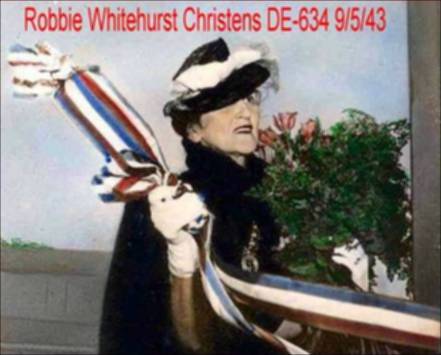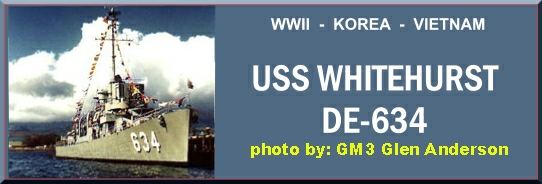|
Whitehurst DE-634 was laid down on
March 21, 1943 at San Francisco, Ca., by the Bethlehem Steel Co., launched
on 5 September 1943; sponsored by Mrs. Robbie Whitehurst, the mother of
Ensign Whitehurst and commissioned on 19 November 1943, Lt Comdr. James R.
Grey in command.


After sea trials, and calibration tests, during a shakedown cruise off the
west coast, headed to San Diego, Whitehurst encountered a severe winter
storm. The ship endured a beating, during which she took several rolls to
port which exceeded 45 degrees. It was on this cruise that Whitehurst
performed her first rescue operation. Upon encountering a fishing boat which
had lost power and was in danger of broaching, she took it in tow to Long
Beach Harbor.
Leaving San Diego Whitehurst proceeded to Hawaii, arriving at Pearl Harbor
on 4 February 1944. Underway for the Solomons on the 7th, the DE sailed via
Majuro and Funafuti in company with James E. Craig DE-201 and Sc-502
escorting SS George Ross, SS George Constantine, and SS Robert Lucas and
arrived on 23 February at Espiritu Santo in the New Hebrides.
After shifting to Noumea, New Caledonia, and back to Epiritu Santo,
Whitehurst joined Osterhaus DE-164 and Acree DE-167 on 22 March to oilers
Kankakee AO-39, Escambia AO-80, and Atascosa AO-66. Whitehurst and Atascosa
were detached from that task unit on 26 March to proceed independently to a
rendezvous with other task forces operating in the area. While Atascosa
refueled ships from Destroyer Squadron (DesRon) 47, an enemy plane appeared.
All ships present opened fire but scored no hits as the plane climbed upward
and out of sight. Once refueling had been completed, Whitehurst and the
oiler returned to Espiritu Santo. At the completion of a mission escorting
President Monroe AP-104 to Milne Bay, New Guinea, Whitehurst remained in
waters off New Guinea on local escort duties until 17 May. She then
participated in the amphibious operation against Wadke Island, screening the
amphibious ships as they landed troops of General McArthur's forces.
Whitehurst, in company with other units of Task Unit (TU) 72.2.9, later
escorted echelon S-4 of the invasion force to Humbolt Bay. The DE
subsequently joined Wilkes DD-441. Swanson DD-443, and Nicholson DD-442 to
screen echelon H-2 as it steamed toward Bosnic, Biak, in the Schouten
Islands, for landings there.
Arriving off Biak on 28 May, Whitehurst took up patrol station off the
western entrance to the channel between Owi Island and Biak. While there she
received an urgent message from LCT-4 which had been taken under fire by
Japanese shore batteries. Whitehurst arrived on the scene in time to be
shelled herself, but the enemy's rounds fell harmlessly nearby causing no
damage. The DE soon was relieved by Stockton DD-646 and Swanson in covering
LCT-84, and then protected LCT-260 as that landing craft embarked casualties
from the beachhead. Whitehurst subsequently screened echelon H-2 as it
retired front Biak to Humbolt Bay.
Whitehurst performed escort duties and trained through the summer of 1944.
The tempo of the war was increasing. With the Japanese being driven from one
Island after another, American planners looked toward the next rung of the
ladder to Tokyo-the Philippine Islands. Accordingly, Whitehurst, Lt. Jack C
Horton, USNR now in command was placed in the antisubmarine and antiaircraft
screen of TU 77.7.1, a group of fleet tankers and ammunition ships slated to
supply units of the 7th fleet on its drive to the Philippines. The ship was
actually in Leyte Gulf on the night of the Battle of Surigao Strait, the
last battle between capital ships of the American and Japanese navies. On 27
October-a week after American troops had landed on Leyte, two enemy planes
attacked Whitehurst. Both were driven off by antiaircraft fire from the
ships guns.
On 29 Oct. Whitehurst received word that, on the previous day, Eversole
DE-404 had been torpedoed and sunk by a Japanese submarine. While Bull
DE-693 picked up survivors from the sunken DE, Whitehurst detached from TU
77.7.1 to conduct a search and soon picked up contact. At general quarters,
the DE conducted three attacks without positive results. When the Whitehurst
pressed home a fourth attack using the "Hedge Hog" weapon, her efforts were
crowned with success. In quick succession , five to seven explosions rumbled
up from the depths. Another violent underwater burst soon followed, causing
a concussion that damaged Whitehurst's detecting gear.
Bull continued the search after Whitehurst, with her damaged sound gear,
requested her to do so, but found nothing except a bunch of disturbed water.
As the waves calmed, lookouts in both ships noticed many pieces of wood and
other debris bobbing in a widening oil slick. The Japanese submarine I-45,
that killed Eversole, had been destroyed. While Bull continued picking up
Eversole survivors in the vicinity, Whitehurst returned to TU 77.7.1 and,
with that task unit, headed back to Kossol Roads in the Palaus.
Nearly a month later, following another stint of local escort operations,
Whitehurst again came to grips with the enemy. While escorting a 12 ship
convoy from Leyte to New Guinea, Whitehurst came under attack by two
Japanese "Lilly" medium bombers. One skimmed low and dropped a bomb that
fell well clear of the ship. The second started a glide bombing attack, but
Whitehurst's guns tumbled that raider into the sea.
After arriving with the convoy at New Guinea on 25 November, Whitehurst
spent the remainder of 1944 and the first few months of 1945 in escort
operations between New Guinea and the Philippines. She did not again engage
the enemy until the Okinawa campaign.
In February, 1945, while the Iwo Jima campaign was in progress, Whitehurst
was sent to Brisbane, Australia to give the crew two weeks of Rest and
Recreation. This stay was cut to one week due to the impending Okinawa
Operation.
Just prior to the Okinawa invasion, Whitehurst was ordered to proceed to the
Kwajalin area of the Marshall Islands, to rendezvous with the battleship New
York, which was enroute to join the Okinawa bombardment force. She kept the
appointment by running at flank speed, 24 knots, for 36 hours straight.
When the American landings on Okinawa commenced on 1 April 1945, Whitehurst
was among the many screening vessels protecting the valuable transports and
cargo vessels. On 6 April, while on patrol station off Kerama Retto, the DE
drove off an enemy plane that had attacked the cargo ship, SS Pierre. Three
days later, the escort vessel was relieved of her duties off Kerama Retto,
and shifted to Okinawa to operate off the southwest coast of that island.
Taking up station on the 10th, she was still steaming in that capacity early
in the afternoon two days later when a low-flying enemy plane closed the
ship only to be driven off by Whitehurst gunfire. At 1430, four Val
dive-bombers approached the area from the south; and one detached itself
from the group and headed for the Whitehurst. It circled and soon commenced
a steep dive while two of his companions also commenced attack, one from the
starboard beam and one from astern. The latter 2 planes spun down in flames,
destroyed by antiaircraft fire, but the original attacker continued down in
spite of the 20mm hits that tore at the plane. This Val crashed into the
ship's forward superstructure on the port side of the pilot house,
penetrating bulkheads and starting fires that enveloped the entire bridge,
while the plane's bomb continued thru the ship and exploded some 50 feet off
the starboard bow. Forty-two men were lost in a fiery instant.
Whitehurst circled, out of control, while Vigilance AM-324 patrolling a
nearby sector, rang up flank speed and raced toward the burning DE to render
assistance. By the time Vigilance finally caught up with Whitehurst, the
escort's crew had put out the most serious fires, but the mine sweeper
proved invaluable in aiding the wounded. The prompt and efficient
administering of first aid and the injection of plasma, undoubtedly saved
many lives. Twenty-one of the twenty-three transferred to Vigilance were
saved. The sixty-five casualties suffered in this attack took almost one
third of the ships compliment, 210 men and officers.
With a Vigilance signalman (Whitehurst's signal bridge personnel had been
decimated) the damaged DE limped into Kerama Retto for temporary patching.
Then seaworthy enough for the voyage to Hawaii, Whitehurst reached Pearl
Harbor on 10 May and was docked for repairs and alterations. Once the yard
work had been completed and ship converted to a floating power station,
Whitehurst departed Pearl Harbor on 25 July 1945, bound for the Philippine
Islands. Soon after she reached Luzon, Japan capitulated. Nevertheless, the
ship supplied the city of Manila with power from August through October of
1945. She was scheduled to depart Manila on 1 November, bound for Guam, but
a Typhoon in the vicinity resulted in a two day delay. Whitehurst eventually
reached Guam on the afternoon of 7 November.
Operating as a unit of Escort Division 40, Whitehurst supplied electrical
power to the dredge YM-25 into 1946. Returning to the continental U.S. in
April 1946, Whitehurst was decommissioned on 27 November 1946 and placed in
the Atlantic Reserve Fleet at Green Cove Springs, FL, in January 1947.
But being decommissioned did not mean the Whitehurst had no duties. She was
immediately manned with enough Firemen, Machinist Mates, and Electricians
Mates to keep the boilers hot, and the turbines, and generators running. The
ship supplied power to the moth balled fleet in Green Cove Springs until
being Recommissioned in 1950. The crew had 3 section liberty. Most lived on
the "beach" and ate in the mess hall on the base. Quoting Dann Linn EM3/c
who was onboard then and contributed this paragraph, "We had it great. I
don't know why I got out. HA!"

|

